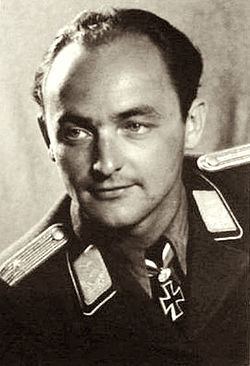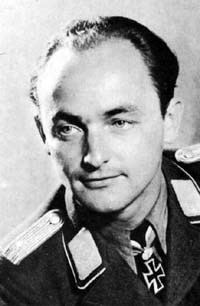Unit JG 51, JG 3 | Years of service 1939–45 Name Gunther Schack | |
 | ||
Born 12 November 1917Bartenstein ( 1917-11-12 ) Died 14 June 2003(2003-06-14) (aged 85)Schmidt near Nideggen | ||
Günther Schack (12 November 1917 – 14 June 2003) was a German World War II fighter ace who served in the Luftwaffe from 1939 until the end of World War II in 1945. A flying ace or fighter ace is a military aviator credited with shooting down five or more enemy aircraft during aerial combat. He was a recipient of the Oakleaves to the Knight's Cross in recognition of his combat success. He claimed 174 enemy aircraft shot down, all of them on the Russian front. He survived being shot down 15 times during his 780 combat missions. After the war he lived secluded in the Eifel Mountains, and devoted himself to philosophical research.
Contents
Early life
Günther Schack was born in Bartenstein in Eastern Prussia in 1917 as the son of a doctor. He studied at the University of Stuttgart and at the Rheinisch-Westfälische Technische Hochschule in Aachen.
Military career
Schack was accepted into the Luftwaffe on 2 September 1939. After being trained as a fighter pilot, Gefreiter (Privat First Class) Schhack was posted to 7th Staffel of Jagdgeschwader 51 (JG 51—7th Squadron of the 51st Fighter Wing) on 18 March 1941.

Schack claimed his first aerial victory in combat on 23 July 1941 on the Eastern Front. He struggled to score against the poorly led and poorly trained Soviet pilots. He achieved his third air victory after 100 combat missions, on 10 November 1941. He flew his 250th combat mission on 30 July 1942, when he claimed only his 5th aerial victory. In November 1942, with his personal score now at 18, his unit returned to Jesau in East Prussia to re-equip onto the new Focke Wulf Fw 190A fighter.
He returned to the Eastern Front, still serving in the 7./JG 51, whereupon his career started to take off. On 17 December 1942, on his first mission back at the front, Schack shot down five Soviet Petlyakov Pe-2 bombers within minutes of each other. Six weeks later, on 29 January 1943 Schack almost repeated this when his Schwarm (flight of four aircraft), on a Junkers Ju 87 escort mission, encountered eight Soviet Petlyakov Pe-2 flying in a line astern crossing the German lines at Novosil. Within five minutes all eight were shot down including four by Schack. He was promoted to Leutnant (Second Lieutenant) on 1 January 1943, and after his 48th aerial victory (on 1 April 1943), he was ordered back to Germany to serve as a flight instructor with Ergänzungs-Jagdgruppe Ost.
He returned to the front in early July 1943, this time posted to 8./JG 51, and back on the Bf 109-G. Part of III./JG 51, it was based at Bryansk covering the northern pincer attack for the Battle of Kursk. He claimed 10 victories in July and but then a further 40 in August. Flying out of Konotop on 1 September, he flew four missions, and had to belly-land after each one. He reached his century-mark in aerial combat on 3 September 1943, and was awarded the Knight's Cross of the Iron Cross on 26 October for 116 victories. He was the 52nd Luftwaffe pilot to achieve the century-mark. On 9 December 1943, as an Oberleutnant, he was made Staffelkapitän (squadron leader) of 9./JG 51.
1944 saw the German forces pushed inexorably out of Russia and III./JG 51 covered the retreat of Army Group Centre, moving from Orsha to Terespol then back to Minsk and Kaunus, with Günther scoring consistently. Oberleutnant Schack was awarded the Knight's Cross of the Iron Cross with Oak Leaves on 20 April 1944 for 133 aerial victories. Schack was then promoted to Hauptmann (Captain) on 1 July 1944 and on 13 August became the 28th pilot to score 150 victories. On 16 December 1944, he became a Gruppenkommandeur (Group Commander), in charge of I./JG 51. By now, the Gruppe had been forced back to the Baltic coast in East Prussia. On 12 April he had to bail out following aerial combat, and suffered serious burns. Soon after, in late April, the Gruppe was disbanded, and on 1 May 1945, he was named the final commander of the IV./JG 3 "Udet". By the end of the war, he had scored 174 victories in 780 aerial combats, and was shot down 15 times (taking to his parachute four times).
Later life
Schack was once shot down by Lieutenant Hollis "Bud" Nowlin of the 357th Fighter Group over East Prussia. Nowlin and Schack met again first in Germany and then again in the fall of 1991 at the 357th Fighter Group reunion in Georgia.
